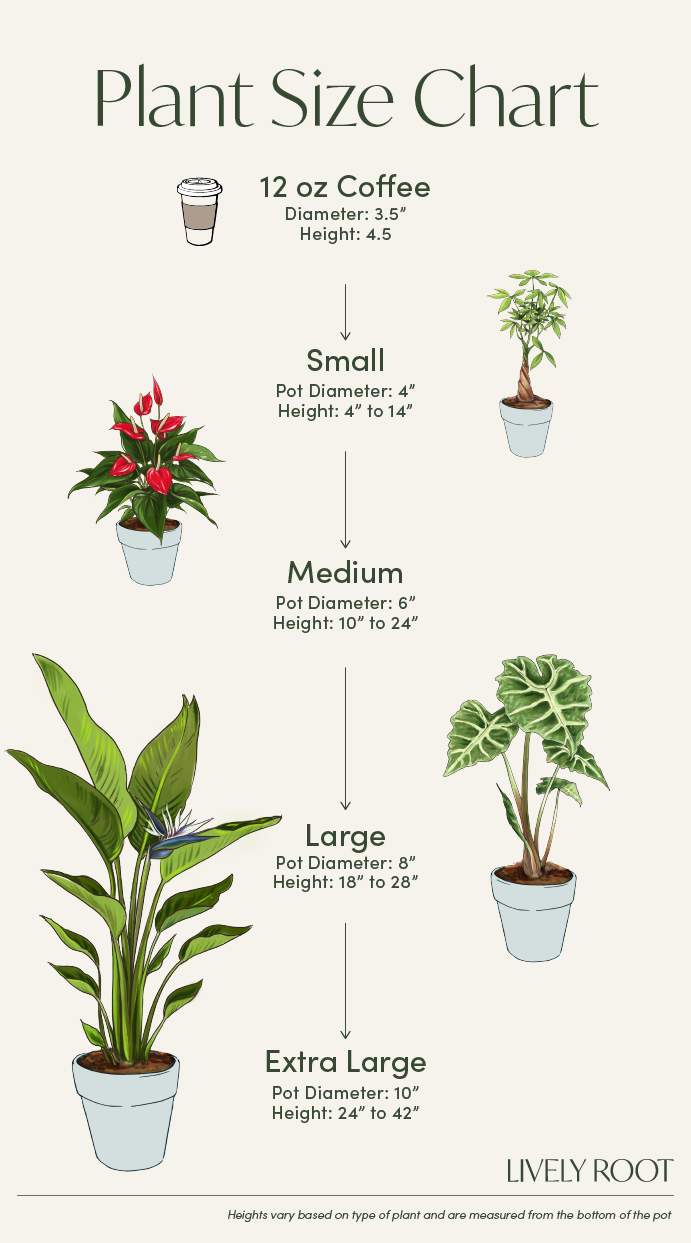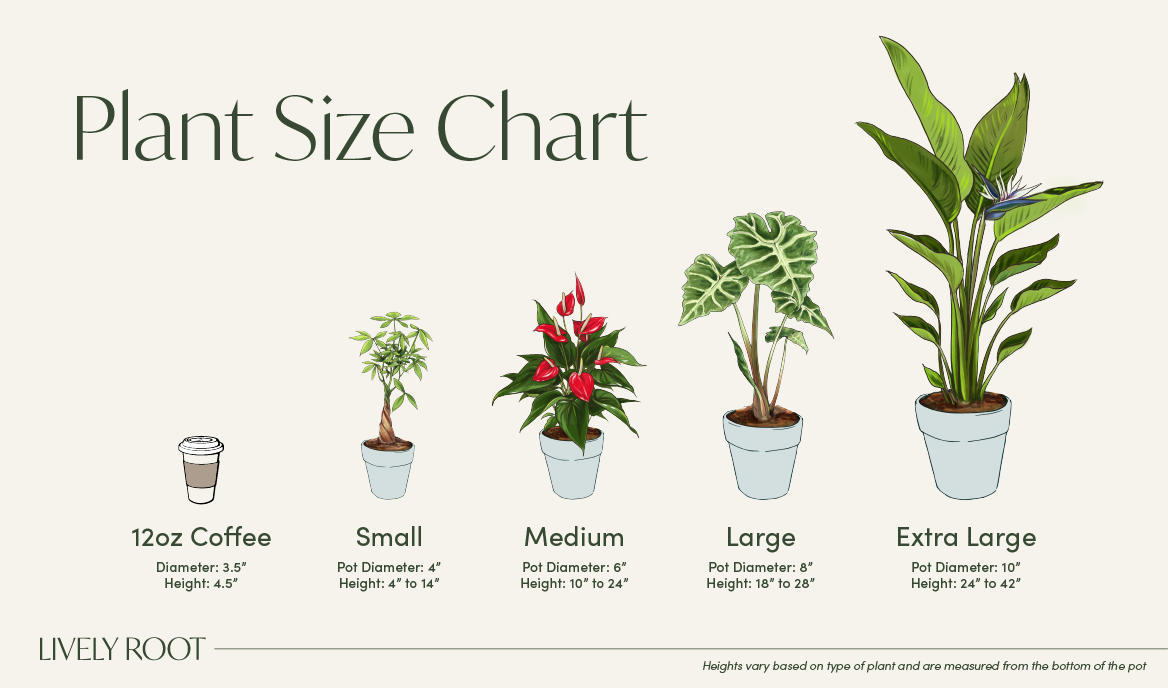

Fiddle Leaf Fig Tree (Ficus Lyrata)' is a gorgeous plant known for their large leaves and vibrant green colors. It prefers a stable environment without much change and doesn't tolerate neglect. The Fiddle Leaf Fig is one of the most loved and iconic ficus varieties, popular among experienced and novice indoor gardeners.
This plant is known to have a blemish here or there. They are part of the plant's lifecycle and we love them anyway!
Fiddle Leaf Fig Tree Care Guide & Presentation

Medium to bright indirect light. Never direct sunlight.
Enjoys being on the moist, but not soggy side.
Enjoys high humidity. Spritz occasionally.
Avoid cold drafts under 50°F and no hotter than 95°F during the day.
Outside: Grow in early morning sun (2-4 hours) where nights are above 50°F.
Indoors: The Fiddle Leaf Fig prefers bright, indirect light for at least six hours in a southern, eastern and western windows.
Fertilize once a month during the growing spring and summer with a balanced liquid fertilizer or topical granular soil fertilizer. Let the plant rest in the fall and winter.
When receiving the plant, do not repot immediately but wait at least 6-12 months or if the roots are beginning to get crowded and growing through the drainage holes.
Repot in the spring, using a 2" bigger pot to keep the roots drier. (Too big of a pot could cause the soil to dry slower, which is not helpful.) Use a well-draining indoor potting mix with perlite to help with drainage.
Water your plant in the old pot before transferring over and let sit an hour. Place a piece of screening at the bottom of the container over the drainage hole to secure the soil and allow to drain. Add soil to the bottom to elevate the root ball. Lift the plant and release the roots against the existing planter. Use a clean knife or garden trowel to wedge between the pot and the soil to loosen.
Inspect the root ball. Notice if there are any dead or rotting roots and trim off with sterile pruners. If the plant is rootbound, cut through the roots to alleviate continued encircling.
Note: If your Fiddle Leaf Fig has outgrown their space inside, cut back the roots by 20% to stunt their growth and add new potting soil to the existing container.
Ensure the plant is sitting about 1" below the edge of the pot to avoid water spillage. Add more soil and backfill around the sides by tamping down. Fill up to the soil line but not over.
Water thoroughly, leaving the soil damp but not soggy. If settling occurs, add more soil.
Gently wipe clean with a soft, damp cloth or paper towel. Work gently from the stem's base toward the leaf's tip, cleaning both sides at once. After cleaning the leaves, remove any dead leaves or debris on the surface of the soil.
Refreshen the soil mixture if needed.
Prune away damaged or diseased leaves down to the stem base with sterile scissors. To prune the Fiddle Leaf Fig, cut between two nodes (where the leaves emerge from the stem). Here the plant will stimulate new growth and branch into two stems, and form young leaves making the fig bushier. Use the pruned stems for propagation.
Take a cutting between two nodes (where the leaves emerge from the stem) with several leaves on the cutting.
Cut the leaves in half in order.
Place the cuttings in a clean glass jar filled with filtered or bottled water and place in a bright, indirect light spot. Change the water each week. After several weeks, white spots will begin to appear on the stem and after approximately 6-8 weeks, roots will emerge.
Use a pot with drainage. and place the roots and stem in damp, well-draining, moist potting soil mix and tamp down around the stem to secure.
Place the stem at least 1-2 inches down into the soil. Set them in bright, indirect sunlight while they are rooting.
Check the moisture and humidity each day and add misting to keep the soil moist while the roots establish.
After 6-8 weeks, roots will begin to establish. You can tug onto the stem to ensure the roots are secure.
Fiddle Leaf Fig Tree: Overview
The gorgeous Fiddle Leaf Fig tree (Ficus lyrata) is a stylish houseplant from the Moraceae family, which includes fruit-bearing mulberry and fig trees. This large plant, native to the tropical rainforests of West Africa, has been prevalent among indoor gardeners for its grand stature, lush foliage, and aesthetic appeal. The Ficus lyrata can easily reach over 10ft. indoors if grown in the right conditions. Outdoors, in hardy zones 9-11, you can have your potted Fiddle Leaf tree as a porch plant but keep it in partial shade. While not the most accessible indoor tree to grow, these spectacular plants can live up to 50 years with the proper care.
Fiddle leaf figs dislike being moved and can react negatively to temperature fluctuations and other environmental variations. Their renowned sensitivity to change makes these beautiful plants tricky for beginners. Another downside of caring for a Fiddle Leaf fig is that its sap is toxic to touch and if ingested by pets.
There are many ficus plants, which come in a variety of shapes and sizes, from the miniature Ficus Ginseng Bonsai (Ficus microcarpa 'Ginseng') to the tall and lush Weeping Fig Tree (Ficus benjamina).
Ficus Lyrata Benefits
- Improves air quality and removes toxins from the air
- It enhances sleep and reduces stress
- Symbol of luck and abundance in Feng Shui
- The plant has noise-absorbing properties
- Aesthetically appealing in any interior space
Fiddle Leaf Fig Tree: Common Names
- Fiddle-Leaf Fig
- Banjo Fig
- Lyre Leaf Fig Tree
Fiddle Leaf Fig Care Guide
The Fiddle lLaf Fig itree is a finicky green beauty requiring extra effort. Provide your glamorous Fiddle Leaf Fig with the ideal growing conditions and watch it thrive, adding a unique charm to your home’s interior!
Watering
It’s crucial to avoid overwatering your plant. Only water your Fiddle Leaf Fig when the top two inches of the soil are dry. You might want a digital moisture meter to show you exactly when to water; the moisture range should be between 3 and 4.
Light, Temperature, and Humidity
Your Fiddle Leaf Fig plant will appreciate a spot with evenly bright, indirect light. Keep it away from direct sunlight to prevent leaf burn, but ensure your plant receives at least six hours of bright light daily. These plants grow best in moderately warm temperatures, between 65°F and 85°F. Mist your Ficus lyrata occasionally to increase humidity when needed.
Soil, Repotting, and Fertilizing
Proper Fiddle Leaf Fig care includes choosing the best potting soil mix for your plant. Use well-draining soil to ensure good aeration around the roots. Repot your Ficus lyrata into a new, slightly larger pot every year, preferably during spring. Trim any damaged roots and use fresh, well-draining soil. Fertilize your Fiddle Leaf Fig tree with a balanced fertilizer monthly during the growing season.
Fiddle Leaf Fig: Propagation
It’s easy to propagate your Fiddle Leaf Fig from stem cuttings by placing them in a jar with filtered water. Change the water regularly until you see tiny roots growing. You can also root the cuttings in the soil. Air-layering is another propagation method that works for Ficus lyrata plants.
Pruning, Cleaning, and Common Issues
A large Fiddle Leaf fig may require pruning occasionally to remove damaged leaves and encourage branching. Wipe the plant’s leaves with a soft, damp cloth to remove dust. Common fiddle leaf fig issues include drooping and yellow leaves as a reaction against sudden changes in the plant’s environment, browning leaf tips from underwatering and sunburn, and root rot due to overwatering.
Fiddle Leaf Fig Tree: Placement, Companion & Alternative Plants
When choosing a Fiddle Leaf Fig for sale, it’s a good idea to consider its best placement and the right companion plants.
Best Locations & Uses
- An ideal bedroom plant, as the Fiddle Leaf Fig tree cleans the air, absorbs sound, and improves sleep quality
- Perfect as a focal point in interior decorating because of its spectacular leaves
- Great for experienced plant owners who are up to the challenge of growing this picky plant
- Suitable for large spaces as Ficus lyrata can grow into a tall indoor tree
- The Fiddle Leaf tree is ideal for south-facing windows and brightly lit rooms
Companion Plants
Create your personalized plant display with these beautiful sun-loving tropical plants:
- Orange Flower Bird of Paradise (Strelitzia reginea): A large, flowering plant, the Orange Flower Bird of Paradise will bring out your fiddle leaf fig with its glossy, smooth leaves.
- Umbrella Tree Plant (Schefflera Gold Capella): Easy to care for and fast-growing, the Umbrella Tree Plant will enchant you with its airy leaf rosettes in variegated green and gold.
- Flamingo Flower (Anthurium spp.): Add some drama to your plant display with the striking Flamingo Flower, easily recognized by its long-lasting, heart-shaped red flowers.
Alternative Plants
If you have a pet, consider these pet-friendly alternatives to the Fiddle Leaf Fig tree:
- Compact Star Prayer Plant (Calathea setosa): The Compact Star Prayer Plant is a beautiful pet-friendly plant that will add a tropical note to your home’s interior with its colorfully striped foliage.
- Money Tree Plant (Pachira aquatica): A gorgeous indoor plant, the pet-friendly Money Tree is a popular good-luck plant in Feng Shui, believed to attract prosperity and abundance.
- Baby Rubber Plant (Peperomia obtusifolia): The pet-safe and low-maintenance Baby Rubber Plant sports adorable round, glossy green leaves.
Get a Fiddle Leaf Fig Tree for Sale From Lively Root Today
Choose a stunning Fiddle Leaf Fig for sale from Lively Root to display in your home or to gift to a friend!










































































